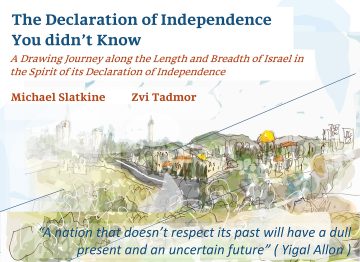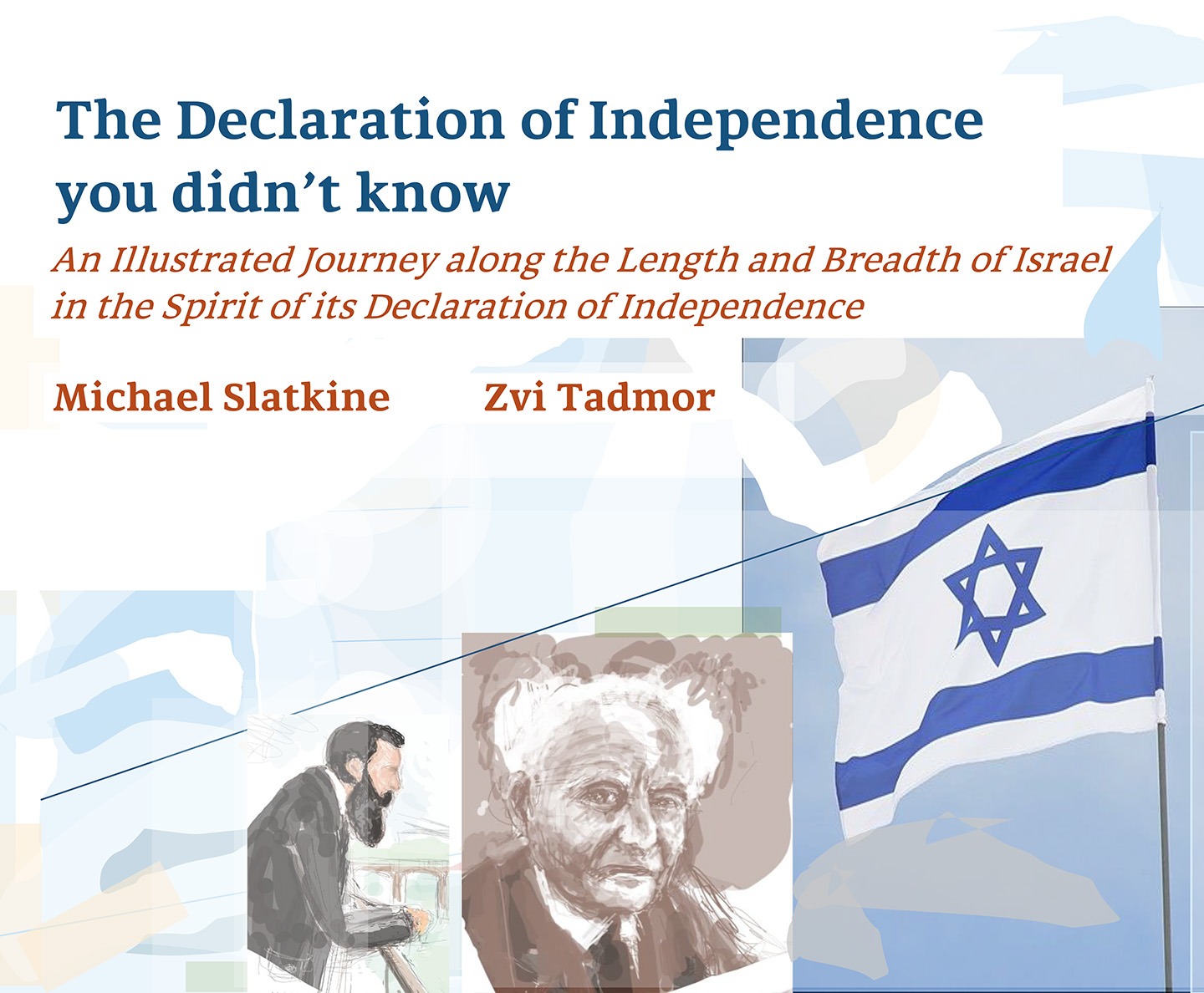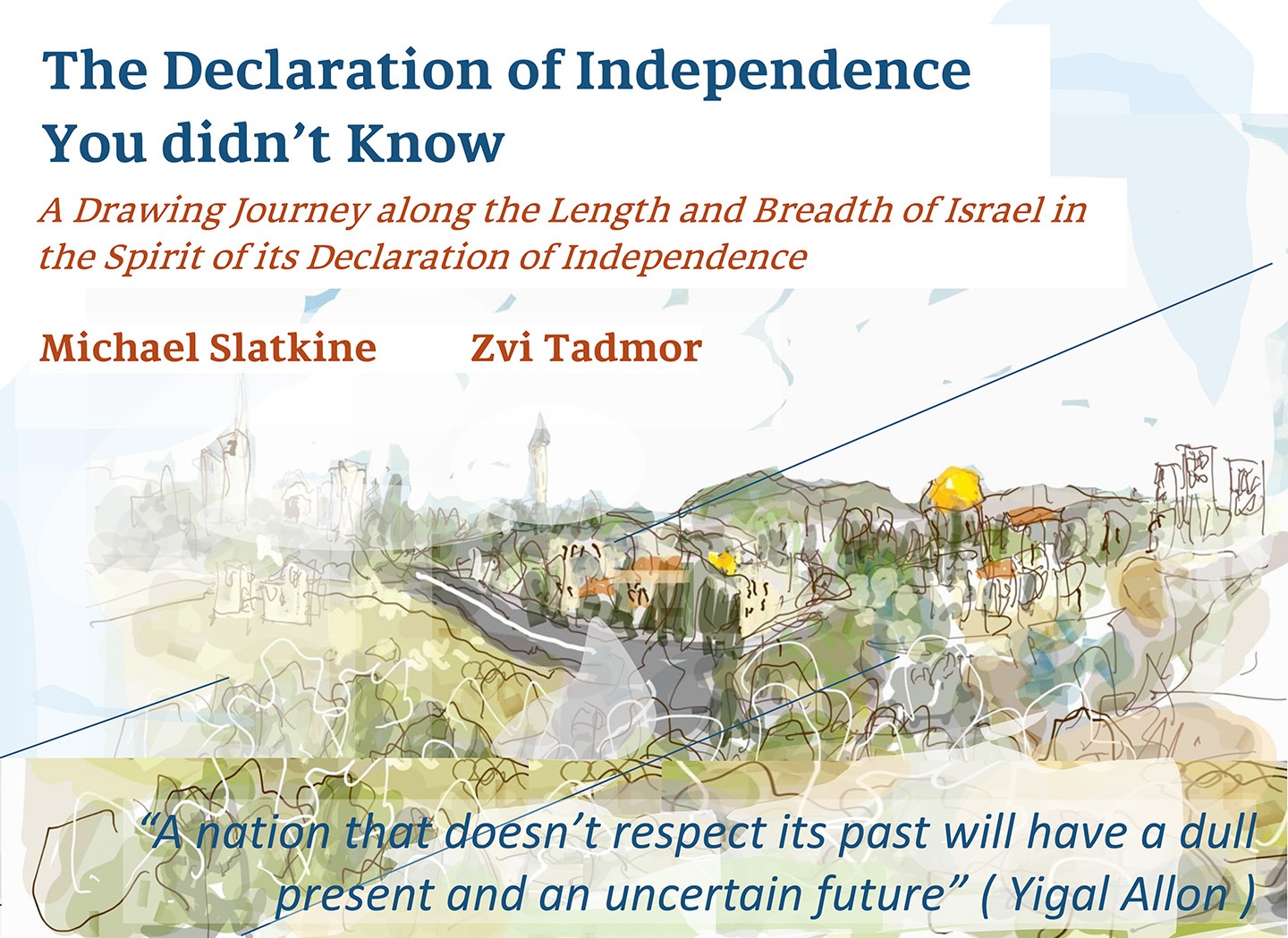An Illustrated Journey along the Length and Breadth of Israel in the Spirit of its Declaration of Independence
Recently, seventy-five years after the establishment of the state of Israel, the “Declaration of Independence” returned and grabbed “headlines” in Israeli and Jewish society. A large sector of the public feels the need and considers it important to revisit the Declaration of Independence, and to draw strength from it in the struggle for its principles and values. The idea to illustrate the Declaration of Independence was actually born in these fateful days, in which we find ourselves, at a time when we are facing a major crossroad of identity. Perhaps the time has come to return to the starting point of the establishment of the state on May 14, 1948, bringing to our hearts the ideas and principles embodied in the Declaration of Independence, that were agreed upon and signed by the nation’s leaders of all political fractions.
The artistic work of Michael Slatkine makes the Declaration of Independence accessible to us with the help of a visual dimension – a visual like no other. His illustrations reflect great optimism and a good spirit, when they accompany the literal content of the Declaration. Thus, they add and give it greater meaning, and value along with the familiarity of landscapes, places and personalities.
The Declaration of Independence
Many see the Declaration as a document, declaring the fundamental principles of rule in the State of Israel. As stated in the Declaration: “The State of Israel…will be founded on the foundations of freedom, justice and peace in the light of the vision of the Prophets of Israel. There will be complete social and political equality of rights for all its citizens, without discrimination of religion, race or gender.” It will also guarantee freedom of opinion, language, education and culture, as well as safeguarding the holy places of all religions. Full and equal citizenship for all ethnic minorities, and seeking peace with the neighbouring countries.
Israeli governments see the Declaration of Independence as a document of moral-legal importance that guides. In 1992, in furtherance of the Declaration, two basic laws were ennacted: the Basic Law on Human Dignity and Freedom, and the Basic Law on Freedom of Occupation. These laws strengthened the legal status of the Declaration of Independence. The Declaration of Independence states that an elected parliament will be established “in accordance with a constitution to be written by the future elected constituent assembly (the Knesset) no later than October 1, 1948”. To date, seventy-five years after its establishment, the State of Israel does not yet have a constitution. In a country that does not have agreed borders, that does not have a full charter of human rights, and the Israeli governance is not fully anchored in a constitution, there a need to continue to cling to the Declaration of Independence.
The Declaration of Independence embodies the over three thousand-year history of the people of Israel, which began in the Land of Israel, where the Jewish Nation was born and and formed and created cultural assets. Two thousand years after the Jews were exiled from their land, to which all generations longed, they began to return and resettle the Land of Israel and revive their Hebrew language.
After about fifty years, the vision of Benjamin Ze’ev Herzl and the Zionist movement was fulfilled and the Jewish people won their national uprising. In the Balfour Declaration in 1917, the Jewish people were promised the establishment of a national home in the Land of Israel, which was confirmed by the mandate of the League of Nations in 1920 and recognized the right of the Jewish people to establish their national home. The Holocaust, which took place in Europe during World War II, in which six million Jews died, required a solution for the Jewish people without a homeland.
In November 1947, the partition plan was approved by Resolution 181 of the United Nations, which recognized the right of the Jewish people to establish a sovereign state alongside that of an Arab state, whose leaders rejected and declared a war.
In the War of Independence, in May 1948, the few against the many defended the lives of the newly born nation. Later, two peace agreements and four “normalization” agreements were signed with six Arab countries. After 75 years of our rebirth we are still fighting for our existence.
Zvi Tadmor
About the authors
Zvi Tadmor, born in Rehovot, obtained a Master degree in geography from the Hebrew University of Jerusalem with a specialization in urban studies. He previously served as a member of the Board of Director of Bank of Israel’s general management. Zvi has been researching the history of the city of Rehovot for over a decade and his research is published on the website of the Rehovot city archive: www.rehovotarchive.org.il
Today he lectures on history and geography, and is also an artist.
Michael Slatkine is a painter and a physicist who shares his time between painting and science. He did his doctorate at the Weizmann Institute of Science in Rehovot and here he was exposed to the uniqueness of the city and its beauty. In the last ten years, Michael has been illustrating many cities in Israel using the E-pencil technique which he has developed, and has published over 800 of his paintings on the website www.israel-in-color.com. In addition he published nine books and over forty videos on the YouTube channel @Israel-in-Color videos
The E-pencil drawing technique
In this book we present 94 illustrations of communities, cities and landscapes in Israel that reflect each paragraph of the Declaration of Independence according to its fulfillment in 2023. The paintings were made in over a hundred walking tours along the length and breadth of dozens of sites in Israel, where about 800 paintings were produced in just a few years. The production of such a quantity of paintings was made possible thanks to the E-pencil painting technique that I developed. In this technique, the sketches are made from a direct view (not from postcards or photographs), freehand, using a digital pen on the screen of my smartphone (Samsung NOTE 20). During the sketching phase I hardly look at the screen and my eyes are focused on the object. This creates an eye and hand contact without the mediation of thought. The availability of the phone makes it possible to pull it out of the pocket at any place or event that appeals to my heart and sketch it immediately. I don’t need cumbersome tools or preparation time – my studio is in my shirt pocket.


